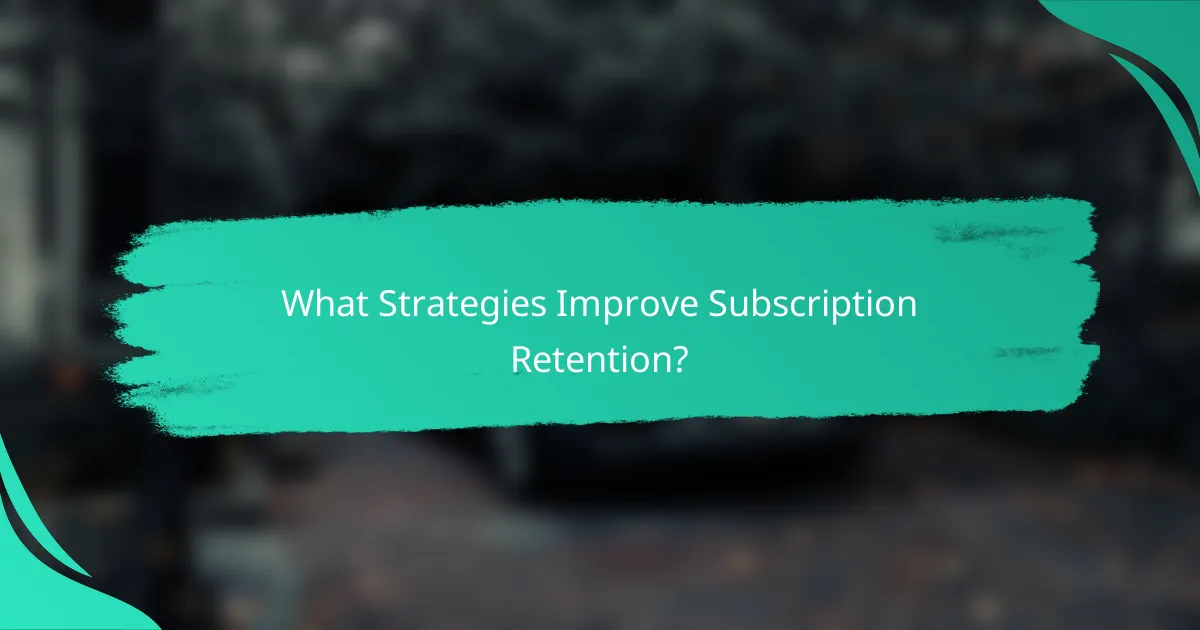Building a successful subscription model requires a deep understanding of your audience and delivering compelling value through a seamless user experience. Retention hinges on customer satisfaction and personalized engagement, while the quality of content plays a crucial role in maintaining subscriber loyalty. By focusing on these key elements, businesses can enhance their subscription offerings and reduce churn rates.

How to Build a Successful Subscription Model?
Building a successful subscription model involves understanding your audience, offering compelling value, and ensuring a seamless user experience. Key elements include defining your target audience, creating a strong value proposition, choosing the right pricing strategy, implementing a user-friendly platform, and effectively utilizing marketing channels.
Define target audience
Identifying your target audience is crucial for tailoring your subscription model. Consider demographics such as age, location, interests, and purchasing behavior to understand who will benefit most from your service.
Utilize surveys, social media insights, and market research to gather data. This information will help you create content and features that resonate with your audience, ultimately driving subscriptions.
Create value proposition
Your value proposition should clearly articulate what makes your subscription service unique and why customers should choose it over competitors. Focus on the benefits your service offers, such as exclusive content, convenience, or cost savings.
To strengthen your proposition, consider offering free trials or introductory pricing. This allows potential subscribers to experience the value firsthand before committing.
Choose pricing strategy
Selecting the right pricing strategy is essential for attracting and retaining subscribers. Consider options like tiered pricing, where you offer different levels of service at varying price points, or a flat monthly fee.
Research competitors’ pricing to ensure your rates are competitive while still reflecting the value you provide. Keep in mind that pricing can be adjusted based on market response and customer feedback.
Implement user-friendly platform
A user-friendly platform enhances the subscriber experience and reduces churn. Ensure your website or app is easy to navigate, with a straightforward sign-up process and clear instructions on accessing content.
Regularly test the platform for usability and gather feedback from users to identify areas for improvement. Mobile optimization is also critical, as many users will access your service via smartphones or tablets.
Utilize marketing channels
Effective marketing is vital for attracting new subscribers. Use a mix of channels such as social media, email marketing, and content marketing to reach your audience where they are most active.
Consider leveraging partnerships or affiliate marketing to expand your reach. Regularly analyze the performance of your marketing efforts to refine your strategies and maximize return on investment.

What Strategies Improve Subscription Retention?
Improving subscription retention requires a multi-faceted approach that focuses on customer satisfaction, personalized experiences, and ongoing engagement. By implementing effective strategies, businesses can foster loyalty and reduce churn rates.
Enhance customer support
Providing exceptional customer support is crucial for retaining subscribers. Quick response times and knowledgeable representatives can significantly improve user satisfaction. Consider offering multiple support channels, such as live chat, email, and phone support, to cater to different preferences.
Regularly training support staff on product updates and common issues can help them assist customers more effectively. Additionally, implementing a feedback loop where customers can share their support experiences can lead to continuous improvement.
Offer personalized content
Personalized content can greatly enhance the user experience and encourage subscribers to stay. By analyzing user behavior and preferences, businesses can tailor recommendations and content to individual needs. This could include customized newsletters, targeted promotions, or exclusive content based on user interests.
Utilizing data analytics tools can help identify trends and preferences among subscribers, allowing for more effective personalization strategies. Regularly updating content to reflect changing interests can keep subscribers engaged and coming back for more.
Implement loyalty programs
Loyalty programs can incentivize subscribers to remain engaged with your service. Offering rewards for continued subscriptions, referrals, or engagement can create a sense of value and appreciation. Consider tiered programs where subscribers unlock additional benefits as they remain loyal over time.
Common rewards might include discounts, exclusive access to new features, or bonus content. Clear communication about the benefits of the loyalty program can motivate subscribers to participate actively.
Regularly update offerings
Keeping your offerings fresh and relevant is essential for retaining subscribers. Regular updates can include new features, content, or services that align with subscriber interests. This not only enhances the value of the subscription but also demonstrates a commitment to continuous improvement.
Establish a schedule for updates and communicate these changes to subscribers to maintain their interest. Gathering feedback on new offerings can also help ensure that updates meet subscriber expectations and needs.

How Does Content Value Impact Subscriptions?
Content value significantly influences subscription success by determining user satisfaction and retention. High-quality, engaging content encourages subscribers to remain loyal, while poor content can lead to cancellations.
Quality over quantity
Focusing on quality rather than quantity is essential for subscription services. Providing fewer, but well-researched and engaging pieces can create a stronger connection with subscribers. For instance, a monthly in-depth analysis may hold more value than daily short articles that lack depth.
Prioritize content that resonates with your audience’s interests and needs. Regularly assess feedback to ensure the quality remains high and meets subscriber expectations.
Engagement metrics
Monitoring engagement metrics helps gauge content value and subscriber satisfaction. Key metrics include time spent on content, click-through rates, and social shares. High engagement typically indicates that the content is valuable to subscribers.
Utilize tools like Google Analytics to track these metrics. Regularly review the data to identify trends and adjust your content strategy accordingly, ensuring it aligns with subscriber preferences.
Content variety
Offering a variety of content types can enhance perceived value and cater to diverse subscriber preferences. Consider mixing articles, videos, podcasts, and infographics to keep the content fresh and engaging.
For example, a subscription service might provide weekly articles, bi-weekly podcasts, and monthly webinars. This variety can attract different audience segments and encourage longer subscription durations.
Feedback loops
Establishing feedback loops is crucial for understanding subscriber needs and improving content value. Regularly solicit feedback through surveys, polls, or direct communication to gather insights on what content resonates most.
Act on the feedback received to refine your content strategy. Implementing changes based on subscriber input can significantly enhance satisfaction and retention, ultimately leading to a more successful subscription model.

What Are the Key Metrics for Subscription Success?
The key metrics for subscription success include churn rate, customer lifetime value, and monthly recurring revenue. These metrics help businesses assess their performance, understand customer behavior, and make informed decisions to enhance retention and profitability.
Churn rate
Churn rate measures the percentage of subscribers who cancel their subscriptions within a specific period. A high churn rate indicates potential issues with customer satisfaction or product value, while a low rate suggests strong retention efforts.
To calculate churn rate, divide the number of lost subscribers by the total number of subscribers at the beginning of the period, then multiply by 100. For example, if you start with 1,000 subscribers and lose 50, your churn rate is 5%.
Strategies to reduce churn include improving customer support, offering personalized content, and regularly engaging with subscribers to understand their needs.
Customer lifetime value
Customer lifetime value (CLV) estimates the total revenue a business can expect from a single subscriber throughout their relationship. Understanding CLV helps businesses determine how much they can invest in acquiring new customers.
To calculate CLV, multiply the average revenue per user (ARPU) by the average customer lifespan. For instance, if ARPU is $20 per month and the average customer stays for 24 months, the CLV would be $480.
Increasing CLV can be achieved by enhancing customer experience, upselling additional services, and fostering long-term relationships through loyalty programs.
Monthly recurring revenue
Monthly recurring revenue (MRR) is the predictable revenue a business expects to receive each month from its subscribers. MRR is crucial for financial forecasting and assessing business growth.
To calculate MRR, sum the recurring revenue from all active subscriptions. For example, if you have 100 subscribers paying $10 each month, your MRR is $1,000. Tracking MRR helps identify trends and informs strategic decisions.
To boost MRR, consider implementing tiered pricing models, offering discounts for annual subscriptions, or introducing new features that encourage upgrades.
